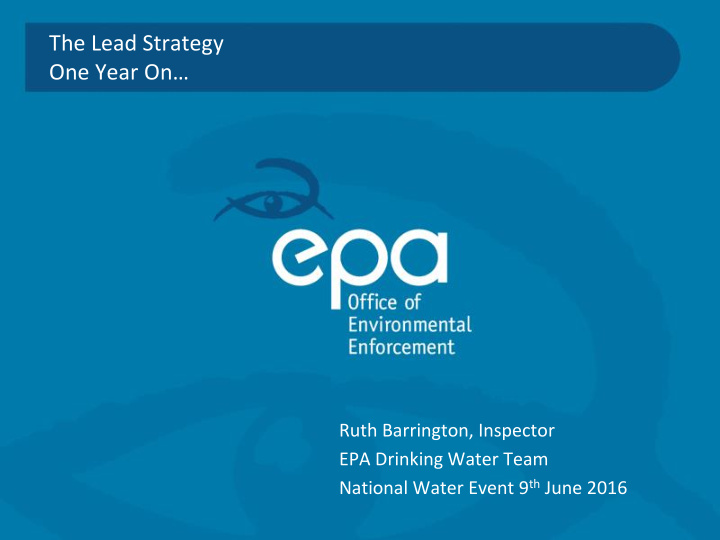



The Lead Strategy One Year On… Ruth Barrington, Inspector EPA Drinking Water Team National Water Event 9 th June 2016
Protection of public health through limiting exposure to lead in drinking water Lead affects brain development - unborn babies, bottle fed infants & young children are most at risk
Drinking Water Regulations Parametric value (limit) has decreased to 10 µg/l No safe level of lead in drinking water (WHO/HSE) Responsibilities of water suppliers and premises owners in relation to exceedances Responsibilities include the internal plumbing of a building Exceedances must be notified to the EPA EPA reports on exceedances annually
Strategy development 2013: Joint Position Paper (HSE/EPA): key points for actions to reduce lead exposure January 2015: EPA Drinking Water Report called for a national strategy on lead in drinking water June 2015: National Strategy published by DoECLG and DoH http://www.environ.ie/water/water-quality/lead-drinking- water/national-lead-strategy-june-2015 June 2015: first phase of Irish Water lead mitigation plan for public consultation Strategies provide a framework for assessing and responding to lead exposure across the population
Responsibilities for distribution pipework- public supply
National Strategy Actions 1-7 Action 1 Raising awareness Action 2 Water providers (Irish Water and Group Water Supplies) Action 3 Removing lead from housing stock Action 4 Education sector Action 5 Hospitals and health care facilities Action 6 Other public bodies Action 7 Research and monitoring
Action 1 Raising awareness EPA/HSE information and guidance to suppliers and consumers Irish Water advice to consumers Development of template letters and advice leaflets to consumers In conjunction with the EPA and the HSE DECLG engagement with stakeholders in health, education, public sectors on plumbing of public buildings, properties they own or operate Grant aid for domestic lead replacement- leaflet and supporting materials to be published by DECLG in June 2016 Action 2: Water suppliers to be dealt with in more detail below
Action 3 Removal of lead from housing stock Ultimate removal of exposure to lead in drinking water Private side lead: provision of advice to property owners, grant aid, IW Opt In scheme DECLG engagement with building regulations on approved materials/fittings (link to Action 1 on advice) Social housing with internal lead plumbing Housing authorities recommended to survey properties DCC pilot use of lead lining system in 20 properties during renovations
Actions 4-6 Education, Health and Public Bodies High level seminar in November 2015 for stakeholders: e.g. HSE, Depts. Education and Health, OPW, CCMA Responsibilities of organisations owning or operating public buildings Provided information on risk and compliance- EPA and HSE DECLG & WSNTG planning workshops for LA Start assessment process- estimate scale of lead plumbing within these properties through lead surveys Start process of designating funding for lead replacement e.g. schools, hospitals on a risk basis
Action 7 Research and monitoring EPA reporting on an annual basis EPA compliance tracking for public supplies on a national basis quarterly since Q1 2016, facilitated by the framework of the national strategy and Irish Water draft mitigation plan Irish Water chemical lining system trial Dublin City Council use of lining systems Proposed orthophosphate treatment in Limerick Expanded Irish Water sampling programme to determine lead levels and help define priority areas
Irish Water Lead in Drinking Water Mitigation Plan Describes plans within Action 2 of the National Strategy Issues Paper published by Irish Water mid June 2015 Irish Water preparation of environmental assessment reports for Strategic Environmental Assessment and Appropriate Assessment legislation (currently) To be followed by 8-12 week statutory consultation period
The scale of lead exceedance (public supplies) Irish Water programme of Random Daytime Sampling Estimated 140,000 houses at risk of lead non-compliance Estimated up to 40,000 additional homes with “backyard shared service” containing lead pipework Public buildings to be assessed Risk prioritisation of individual water supplies- population at risk of lead exposure Output: Irish Water plumbosolvency maps to show high risk supplies- to be used to prioritise mitigation actions
Lead replacement- ultimate goal Both private and public side need to be replaced at the same time Replacement plumbing fittings to be of suitable quality and standards Grant for householders since February 2016 Irish Water Opt In scheme
Lead mitigation options Interim actions to limit exposure prior to lead replacement Corrective water treatment pH adjustment Lead lining systems Point of use filtration Advice to consumers Actions assessed within mitigation plan- e.g. complexity, compliance achieved, cost, delivery time… Corrective water treatment, replacement public and private side lead, replacement public side lead
Corrective water treatment – orthophosphate dosing Orthophosphate as food grade additive Prevent contact of the drinking water with lead, taking 6-24 months to develop coating, maintenance dose then required Irish Water proposal for 400 “high risk” water supplies where technically, economically, environmentally viable Addition of phosphorus to aquatic environment (e.g. through leakage, wastewater) Site specific risk assessment for each proposed supply Range of environmental protection measures may be required Model for risk assessment being developed by Irish Water
Approach: Treatment & Removal in parallel Most Sensitive Lead and backyard service replacement Lead Removal (Schools, etc) Irish Water Lead Mitigation Plan Scope Irish Water “Opt - in” programme (ad -hoc) Domestic / Private / Government / Commercial lead removal (Gov. Strategy) Corrective Treatment Water Orthophosphate Treatment 2021 2025 2019
Limerick Orthophosphate pilot Will enable development of suitable dose and monitoring protocols for an Irish setting (climate/water chemistry/maintenance dose rates) Has been subject to Appropriate Assessment under Habitats Directive Baseline sampling underway so the impact on compliance can be measured Inform Environmental Assessment Methodology for screening “high risk” supplies
What’s next? Irish Water Lead Mitigation Plan SEA public consultation Limerick orthophosphate pilot Continue expanded monitoring programme National Strategy: Individual houses: promotion of lead replacement Public Buildings: assessment & lead replacement Annual progress report
Thank you Acknowledgements EPA Drinking Water Team Ms Marie Archbold, EPA Catchment Science and Management Unit Mr John Hynes, Mr Maurice O’Connell, Irish Water Mr Stephen Dineen, DECLG Ms Catherine Comer, DECLG
Recommend
More recommend